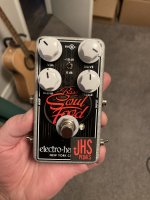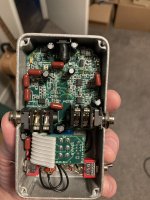jwyles90
Well-known member
I found this at a pawn shop for $15 the other day. They told me that it didn't work, so I figured the worst-case scenario was I take a $15 crash course in messing it up further, best case I fix it and get a working pedal for cheap. It turns on, but no sound other than a high-pitched whine comes through when engaged.
This might sound like kind of a silly question since we all do troubleshooting in one way or another with our own builds. But I'm curious if anyone has any experience or tips for repairing already broken pedals? I figure taking an audio probe to it is a good place to start, and looking for anything that visibly jumps out as damaged. Outside of that, I'd be curious to hear if anyone has had any success repairing pedals elsewhere. I also recognize that SMD repairs could be a totally different kind of beast than through-hole.


This might sound like kind of a silly question since we all do troubleshooting in one way or another with our own builds. But I'm curious if anyone has any experience or tips for repairing already broken pedals? I figure taking an audio probe to it is a good place to start, and looking for anything that visibly jumps out as damaged. Outside of that, I'd be curious to hear if anyone has had any success repairing pedals elsewhere. I also recognize that SMD repairs could be a totally different kind of beast than through-hole.


